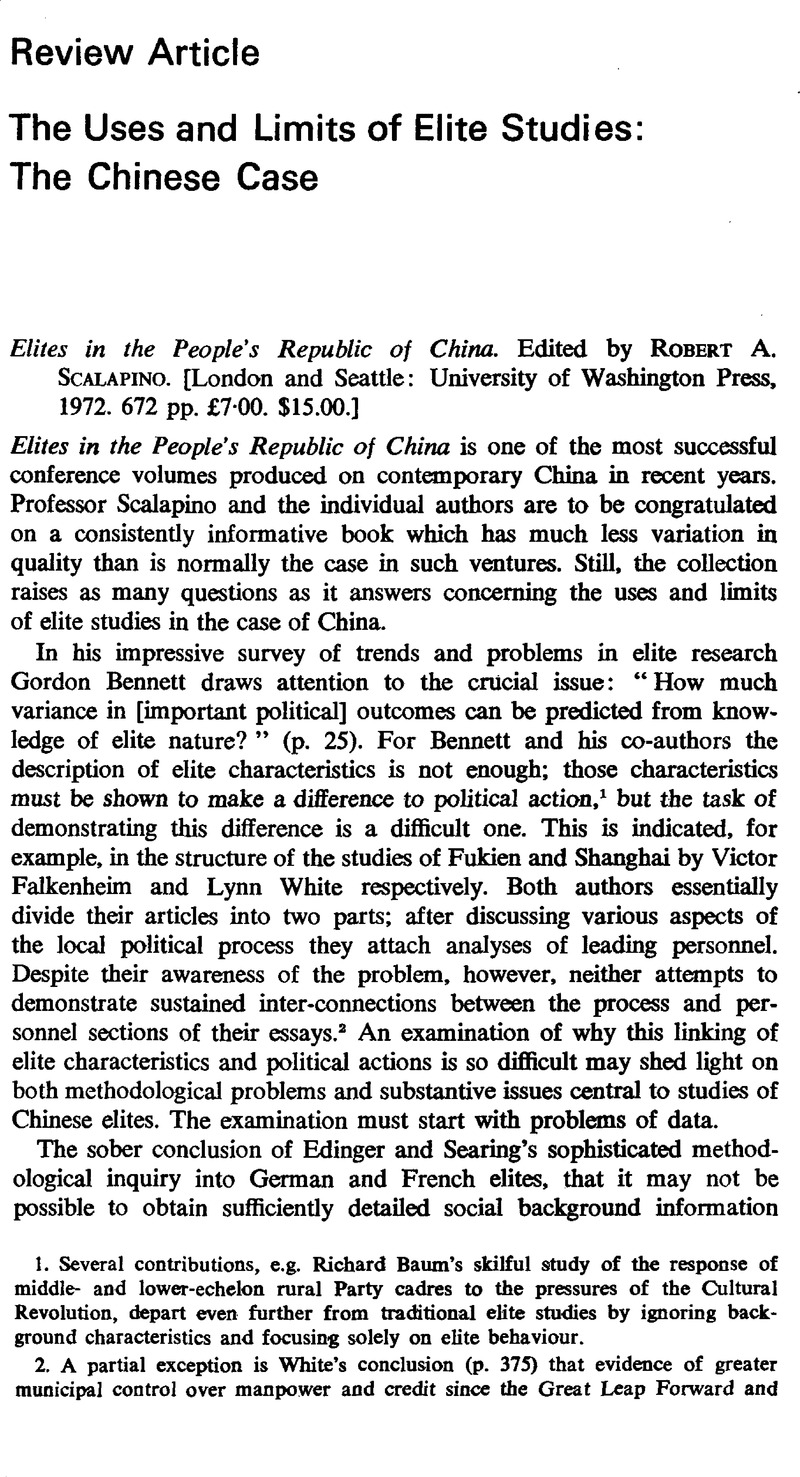Published online by Cambridge University Press: 17 February 2009

2. A partial exception is White's conclusion (p. 375) that evidence of greater municipal control over manpower and credit since the Great Leap Forward and the appointment of locals to vice-mayor posts in the same period both confirm the effect of the Great Leap in making Shanghai an increasingly prominent and separate centre of political leadership. Here elite nature, as well as a political outcome, is viewed as the consequence of another political action. The extent to which political developments shape elite composition is, of course, another key question of elite studies.
3. Edinger, Lewis J. and Searing, Donald D., “Social background in elite analysis: a methodological inquiry,” The American Political Science Review, 06 1967, p. 445Google Scholar .
4. Of course, sophistication in the choice of defined positions for analysis can significantly improve elite studies.
5. The other scholarly works supporting the hypothesis which Chamberlain cites – Oksenberg, Michel, “Local leaders in rural China, 1962–65: individual attributes, bureaucratic positions, and political recruitment,” in Barnett, A. Doak (ed.), Chinese Communist Politics in Action (Seattle: University of Washington Press, 1969)Google Scholar ; and Vogel, Ezra F., Canton under Communism: Programs and Politics in a Provincial Capital, 1949–1968 (Cambridge: Harvard University Press, 1969)Google Scholar – also draw their data from areas with a weak Communist movement before 1949.
6. Hinton, William, Fanshen: A Documentary of Revolution in a Chinese Village (New York: Vintage Books, 1968), pp. 259–68Google Scholar .
7. Moreover, we can speculate that the tendency to rely on cadres with local connections for control purposes in “old liberated areas” was even more pronounced at the country level.
8. In the early stages of the Cultural Revolution cadres undoubtedly recalled the Hundred Flowers period when criticism was initially encouraged from non-Party sources which ultimately came under severe attack.
9. Frequently circumstances force policy decisions that fly in the face of proclivities based on experience. To cite a non-Chinese example, Nixon's imposition of wage and price controls went against deeply ingrained attitudes traceable to both his upbringing and adult experiences. In the case at hand, where both circumstances and (some) experiences presumably worked towards the same outcome, I am only arguing that much less emphasis should be placed on the experiential variable than elite studies generally assume.
10. , Edinger and Searing, “Social background in elite analysis,” pp. 434, 436 and 440Google Scholar.
11. The “military generation” concept is given more detailed treatment in , Whitson, “The concept of military generation: the Chinese Communist case,” Asian Survey, 11 1968Google Scholar .
12. See the various tables in Edinger and Searing, “Social background in elite analysis.” This observation should be made with caution and is largely concerned with “scope“ (the number of attitudes predicted by a background characteristic). Nevertheless, the data do show a tendency for current occupation and political affiliation to be among the best predictors and for more recent experiences to be better predictors than remote ones. It is also noteworthy that the attitudes most susceptible to probabilistic prediction were particularly salient political issues of the day. Ibid. p. 434.
13. Another factor aiding Montaperto's analysis is that the groups examined are compact, i.e. the individuals concerned interacted in the same small arena. More dispersed groups, e.g. configurations of Central Committee members, would be unlikely to have the same degree of shared perceptions no matter how similar their background characteristics since separate operational contexts would create diverse experiences. Finally, Montaperto's study benefits from his uniquely precise data. Through the use of refugee interviewing, he was able to identify both relevant background characteristics and political actions in greater detail than is possible for scholars working with other sources.
14. See my Provincial Party Personnel in Mainland China 1956–1966 (New York: Columbia University East Asian Institute, 1967)Google Scholar , Chap. II; and Provincial Leadership in China: The Cultural Revolution and its Aftermath (Ithaca: Cornell East Asian Publications Series, 1974)Google Scholar .
15. , Whitson, “The Field Army in Chinese Communist military politics,” The China Quarterly, No. 37 (1969), pp. 1–30CrossRefGoogle Scholar .
16. Cf. ibid. pp. 23–24.
17. Similar situations existed for the Tsinan, Inner Mongolia and Tibet Military Regions.
18. , Lowenthal, “Development vs. Utopia in Communist policy,” in Johnson, Chalmers (ed.), Change in Communist Systems (Stanford: Stanford University Press, 1970), p. 112Google ScholarPubMed .